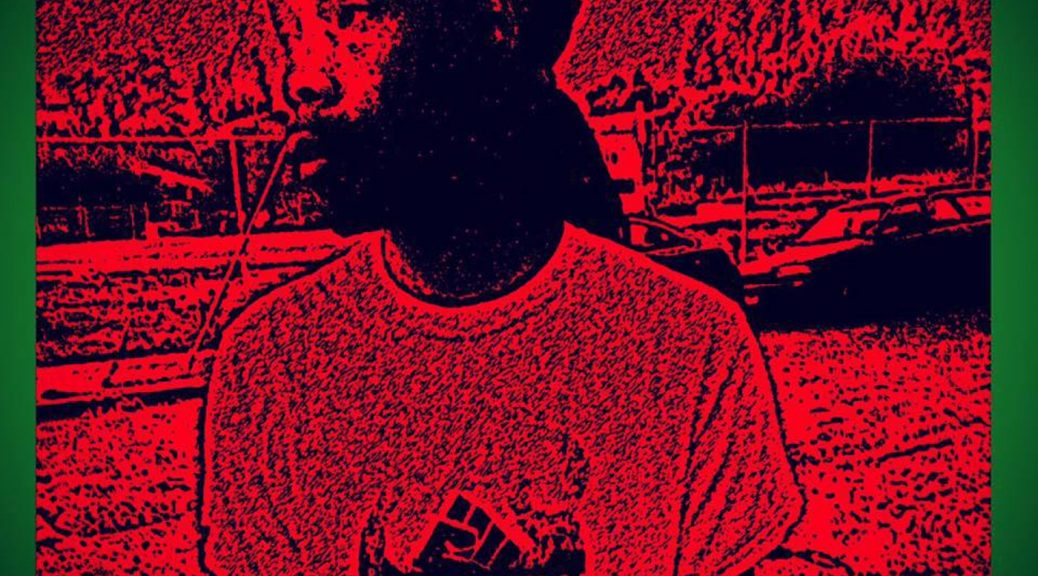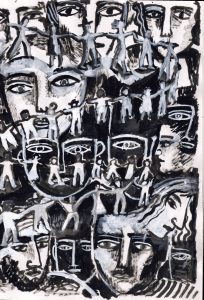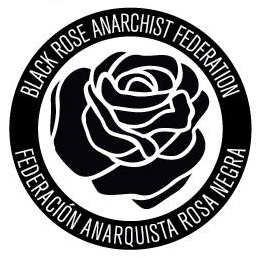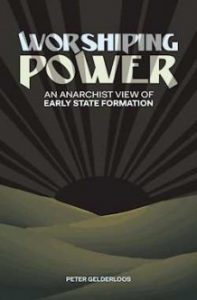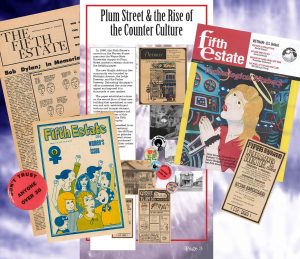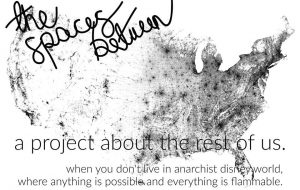Support Janye Waller + Anarchist Thoughts on Tactics at Standing Rock
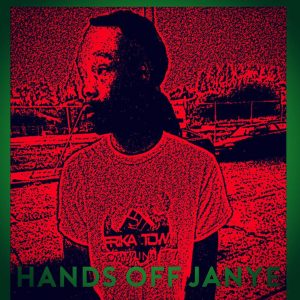
This episodes features two portions: an interview with Noelle about Black revolutionary, Janye Waller, incarcerated in Oakland; then, an interview with Noah about anarchist tactics in the NoDAPL struggle at Standing Rock.
Janye Waller
In the first segment we talk to Noelle about the case of Janye Waller. Janye is a young Black revolutionary from Oakland, California, who was the only person convicted of property destruction after the 2014 demonstrations in the Bay following the non-acquittal of pigs the murders of Michael Brown & Freddie Gray. Noelle is a supporter of Janye Waller and believes that Janye’s conviction was a clear case of railroading and racial profiling against a community activist. Janye is now finishing up a 2 year sentence with one year off for good behavior. The interview was held in February of 2017, and Janye is set to be released in coming months, then he’s out on parole. You can find out more about his case and donate to his post-release fund at https://rally.org/supportjanye and updates can be found on his support fedbook page and to find out more about some projects Janye was involved with in Oakland, check out the site for El Qilombo
You can write to Janye in the near future by addressing letters to:
Janye Waller #ba2719
A Facility,
P.O. Box 2500,
Susanville, CA 96127-2500
Anarchist Observations of the Struggle at Standing Rock
In the second segment William speaks with Noah, who is a well established movement medic, anarchist, and participant in #NoDAPL at Standing Rock, about his experiences there and analyses of how this resistance was organized and how it developed. This interview was recorded days before media saw the images of the Sacred Stone Camp burning and having been disbanded, so many of the modes and tenses that we employ are not what we might given the current position of the camps. We talk about a wide ranging set of topics, from what worked in the camps to what the failings were, and how resistance to extraction industries could look moving forward.
Thanks to 1312 Press for transcription and zine layout (found on Instagram & also email):
For links on how to support the efforts at Standing Rock – which are ongoing and support is needed both for folk’s legal and medical expenses – check out:
Water Protector Legal Collective
Sacred Stone Camp
Medic and Healer Council
Announcements
ACAB2017 End of Submissions
Shortly there’ll be a posted end to a call for submissions for presenters, workshops and bands at the first annual Asheville Another Carolina Anarchist Bookfaire up on the website, but we announce it here. Submission deadline is April 1st, 2017. Spots are filling up fast. Check out the website for updates and we hope to see you there!
TROUBLE showing at Firestorm, March 24th @ 7pm
That about says it. First episode of TROUBLE, which was chatted about in our last episode as the new video series by subMedia will be showing at Firestorm Books & Coffee at 7pm on Friday the 24th of March!
. … . ..
Episode Playlist
. … . ..
Transcription
TFSR: So we’re here to talk about Standing Rock and I’m sure that folks have heard about it if they have been keeping at least half an eye on the news, but for those who haven’t, would you mind giving a brief overview of what the struggle is and what has been happening there?
NOAH: So the Dakota Access Pipeline is a large pipeline that would carry heavy crude oil to refineries in Illinois before getting sent out of the country for foreign consumption. The pipeline is routed to pass just upstream from the Standing Rock Reservation’s water intake, which is part of their concern, as well as the pipeline route
as gone through a number of sacred sites causing the desecration of burial sites and other old religious sites. Back in August (2016) when construction got close to the Missouri River crossing by the Standing Rock reservation, the Sacred Stone Camp, which had been in existence since April, had made a bigger call for support in which many folks responded and that’s when the first arrests took place, lead largely by women and youth from Standing Rock and other Indigenous women and youth. Here you saw some very strong images of women running out onto the Cannon Ball Ranch to block construction equipment which was some of the first real civil disobedience, as well as the Horse Nations coming to just be presented to the law enforcement that was there, but the law enforcement ended up being scared by the presentation of the Horse Nations and so they kinda backed off and fled. That was some very strong imaging right off the bat there.
I arrived not long after that and helped provide medical support for some of the non-violent civil disobedience and just in camp at large, based out of the Red Warrior Camp. Red Warrior Camp was one of the few organizations that really took a strong lead in actual civil disobedience that stopped pipeline construction and were it not for the Red Warrior Camp, Indigenous People’s Power Project, some of the crews, some of the other bands of the Lakota Nations
really stepping up and taking that direct action to the pipeline construction, that pipeline would be said and done by now. And we certainly wouldn’t have cost Dakota Access the millions upon 2millions of dollars we’ve cost them in lost time, delayed contracts and stock price as well as the divestments from the banks which with Seattle and some Native reservations have totaled well over $3 billion worth of money withdrawn from Wells Fargo and punitive response from people. So the divestment is going to leave a lasting mark on these banks’ psyches and their shareholders’ psyches when they think about funding more of these projects.
TFSR: Absolutely, and it seems like along with the actions that have been taken at the various camps, the relationships between the various camps has been also very important to have outreach via social media and awareness being spread in a grassroots way, because mainstream media was very slow seemingly to pick up on
struggles going on at Standing Rock. Do you have anything to say about media blackouts there or anything like that? What has the process been for getting word out?
N: Well certainly it’s been led by some grassroots media projects that have been around since the start of the Sacred Stone Camp. Folks with Unicorn Riot have been there throughout the course of much of this which certainly is where I first started getting my media from
as they did intermittent updates on the Sacred Stone Camp from it’s start and through several stages of it well before Standing Rock or NoDAPL became a more common phrase. I think it was also very important for the largest camp at the Oceti Sakowin camp, the Seven Fire Council Camp, which was kind of just an overflow camp.
TFSR: Was that the youth camp?
N: The International Youth Council had a tipi in that camp for a while, but they were also holding space at Sacred Stone Camp and the Rose Bud Camp. The camps can be confusing when you’re there, and have been confusing. I’m sure it’s particularly hard to keep track of when you’re watching from afar. Sacred Stone Camp is Ladonna Bravebull Allard and her family’s land, which was started
by Ladonna and some other matriarchs from the area and the youth runners back in the start of April. And it was the Dakota Youth Runners who started getting a lot of attention from the long-distance runs they did.
It also needs to be pressed that there have been folks in that region who have been organizing in anticipation of the Keystone XL pipeline coming through Lakota territory that allowed for some of the groups within this larger mass to come together quickly and in an organized manner and show greater levels of discipline and training because we had been training together. We were under the leadership
of Lakota matriarchs and other Lakota elders who understood from the get-go that as these pipelines were coming through, we needed to be able to have a common language around how we fight and how we resist with non-violent civil disobedience. And so folks are familiar, folks understand that there are different roles. If your role is
media for the day, or medic, or police liason, that’s your role for that day and you need to stick to it and if that’s not your role, then you need to not try and make that your role.
So that’s why when the camp was significantly smaller than when it was 12,000 people between the camps, when there were only a few hundred folks in camp there was more effective direct action to stop the pipeline than when there were all these folks who came to stand with Standing Rock but there were no plans to use that mass of people effectively or an unwillingness to utilize any of those plans on the parts of some.
TFSR: Is that just because the camp got so unruly with the size, or do you feel that people were kind of not respecting any directives that were being told to them?
N: No, as I’ve seen it put on the internet, that there was a problem with “peace-chiefs” trying to lead during a war situation. And so there were folks who, in the language I would use, didn’t respect others’ diversity of tactics. And so there were folks who would interfere with Warriors and Water Protectors on the frontline and cause division and even go so far as to utilize spiritual abuse and manipulation to interrupt actions that were happening, or not allow actions to happen or prevent them from happening in very vague ways, like getting outside folks to try and scream at people that “Elders said no!” And what they meant was Dave Archambault and the tribal council might not be happy with what’s going on. But there are a number of different elders in the camp because there
are many different tribes and nations in the camp, but not everyone listens to the same elders. Folks are taught to listen to their elders. The Lakota are not a monolithic group, they disagree with each other. Sometimes the grandmas and aunties would be there telling folks to hold the line while others would be telling them to go back to
camp and pray. To some extent because the camp grew so fast and there wasn’t space made for an all-nations council of any sort, these rifts and problems became rather challenging at times because there was so much to do just in camp life and preparing for the change of the seasons and to try and train and utilize huge numbers of people who were rolling over every few days as well as deal with mountains of supplies coming in.
It all became very challenging, and then you have a real separation of leadership of folks who are contracted by the tribe to help, or were from larger non-profits who largely operated out of the casino rather than the camp. So you have that disconnect of folks who weren’t involved in the camps but were considered leadership for one reason or another, which made things very challenging all in all. When the information about what’s happening in camp gets through games of telephone, you end up with a lot of rumor and heresy added in, or misinformation, and that can be seen by how often facebook says the camp is being raided when we’re not.
TFSR: As an anarchist, I feel almost single-mindedly fixated on this idea of what you were talking about in regards to a non-respect of a diversity of tactics and trying to parse out where a rhetoric of non- violence is coming from. We talk a lot about how liberals have sort of co-opted the idea of non-violence to weaponize it against radical struggle basically, or to weaponize it as a way to take the wind out of sails of radical struggle. I would imagine that this rhetoric of non-violence is a bit different given the layers of colonization and disenfranchisement that people are experiencing. Do you have any words about that?
N: There’s certainly a real challenge for anyone who’s not Lakota or Native to understand the nuance and the history between the Indian Re-Organization Act, Tribal Councils versus the Traditional Treaty Councils. It’s important especially for outsiders to err on the side of listening to the folks who are directly hosting them in these situations and not be overtly disrespectful to local communities. Now that doesn’t mean that local communities are unified in their response, and that’s not really our place as outsiders to really dive right into the middle of it and stir it up. I have been working with some folks who were out there for several years so those were the folks I took my lead from because they are traditional Lakota and Dakota Matriarchs. So with that, there was a division of folks who believed in the courts and believed in that being the primary route and would at times spread disinformation about how the action of folks locking down to equipment or shutting down work sites was going to negatively impact these civil court proceedings. If anything they gave these civil court proceedings the time they needed to get denied, but there hasn’t been a win from the courts in this battle that I’m aware of. So if we were relying solely on those means, the pipeline would have been built by now.
The spark of inspiration that that has come out of Standing Rock would not have been if it weren’t for folks who understand that prayers have to be met half-way. We can’t just pray and expect things to stop, and similarly we have to understand robust histories. You hear this ongoing colonized myth that First Nations Peoples were completely passive or pacifistic when that’s simply not true. It’s well known that many Nations and many people were almost
always armed and prepared to defend their homelands and their territory and their way of life from settler-colonial populations. Part of this myth comes from those boarding schools; it comes from this western narrative that says “It was the white folks that freed the slaves!” and “It was the white folks who were benevolent enough to give these Natives the reservations!” rather than things like, the
6Lakota slaughtered a whole division of the cavalry at the battle of Greasy Grass and killed Custer and took that flag, and that was part of writing the treaty. Red Cloud’s wars and the Big Powder Bluff were the reasons for those treaties, the Northern Cheyenne; the Lakota/Dakota/Nakota’s fierce resistance to the U.S. incursions
and these settler/colonial incursions are what created these treaties. It’s also what provoked the U.S. into using genocidal tactics such as slaughtering all the buffalo and stripping Natives from their culture to send them to boarding school, so they could re-write those narratives
and send those kids back to those cultures with this wrong narrative.
And so with that you have this Christian idea of forgiveness that is pressed, or of understanding, and I personally hope that those cops and law enforcement come to some dawning of understanding that their ways are bad. But until that happens I have no sympathy for them or no forgiveness for their behaviors until they seek it. And so it’s something that personally baffles me, especially coming from a medic’s perspective and seeing the grievous injuries that we’ve seen out there. That folks want to negotiate with these people or work with them to get into that system. It’s one of those things, some folks who don’t want the (Water) Protectors to continue resisting are legitimately scared that those cops are going to kill one of us. And that’s a very real possibility but it also disrespects a lot of those folks’ agency, who understand that they may die in this struggle. And that if the state is going to go through such measures and allow their law enforcement to utilize these munitions, these so-called less-than-lethal munitions in reckless ways, then yeah they may end up killing someone but you know if they kill a Water Protector whose got their hands up and are in prayer, isn’t that that non-violent Ghandian King-esque nonviolence that they’re talking about? Let them harm us to the point that the moral imperative becomes so overwhelmingly against them that they have to give up? That they don’t have the will to beat you any longer?
TFSR: Also in a time when we have this new president now who is actively seeking to criminalize so-called peaceful protesters? Seeking any kind of legitimacy from the state doesn’t make a whole hell of a lot of sense, but what also makes a lot of sense is taking leadership from people who are most effected and also keeping in mind that that’s a non-homogenous group of people. It’s a very complicated situation, it seems like it’s very difficult to know where to draw the line while also maintaining your own political integrity in all of this as well, to be a whole human being. You mention that you are a movement medic, and you have spoken about your experiences at Standing Rock, but I was wondering if there was anything that you wanted to add about your involvement at the camp?
N: My involvement at the camp has largely been as a medic in support of the Water Protectors, so I’ve both worked to help increase the medic capacity and continue to work to try and help us stay coordinated and functioning in a way that allows us to provide the best level of care that we can. I have also gone out on a number of the direct actions to support Water Protectors and have dealt with some injuries and elements and the volumes, which were pretty staggering at times. November 20th when they just kept using water cannons on folks, both speaks to the heart and willingness of the water protectors but from the medic’s perspective we saw over 300 patients that night.
Several folks were severely injured; Sophia Wilansky nearly lost her arm that night, and other folks have lost permanent vision from that night, and the level of PTSD that has been inflicted on folks in these situations or the potential for it.
Similarly when the Sacred Ground Camp on the Easement was raided on October 27th, they literally just lined up and whooped on folks all day. We’re seeing the Miami Model play out in rural settings. Sheriff Laney from Cass County and Sheriff Meyer from Morton County I’m sure will retire real soon and go on the law enforcement and security speaking tour, to pop up at every pipeline and give advice
on how to deal with these “damn eco-terrorist protestor types.”
TFSR: And there has been a whole lot of law enforcement there from day one it seems, right?
N: Not from day one, I mean Morton County I think employs 33 or 39 sheriffs total. (*laughter*) And the North Dakota State Police and Highway Patrol could only muster so many folks, but now law enforcement from nine other states, federal agencies like the ATF and Border Patrol have been deployed out there. There is I believe just more than 500 North Dakota National Guardsmen who are activated presently. There is now quite the policing apparatus as was on display when the Last Child Camp was raided and shut down. They had over six armored vehicles out that day.
TFSR: It feels important to analyze police responses to struggles like this in order to get a psychological hold on to what the hell is going on, and we’ve been seeing a lot of media recently about the struggle, and many different approaches from total erasure to pretty heartfelt support. I’m wondering what your opinions are about how you see
this struggle informing future struggles and how you see this one particularly continuing, or if it’s too early to say?
N: I think at the very least what has happened out there in the treaty territories has brought a new level of what it looks like to be brave in the face of the state for folks. And it’s behaviors it can be pointed to as strong definitive attempts at non-violent action that we’ve already seen. At the Piñon Pipeline, there was one action out there and they cancelled it. At the Trans-Pecos Pipeline, there have been a couple of actions already and they’ve shut down work. Mississippi Stand went after other sections of the Dakota Access Pipeline down in Iowa, we’re seeing folks starting to really resist the Sabal Pipeline, Spectra Pipeline, Lancaster PA is starting to openly build camps and openly express how we aren’t paid outside agitators, here’s the local teacher. These are local folks who are stepping up and saying “Oh heck no, can we do this here?” I think it’s important as we do this that we need to understand that there is a space for specifically prayerful things, and there is a space specifically for the prayer war, and there is a space for the more confrontational direct action tactics, but these are not the same space.
And I think it needs to be stressed that the Water Protectors and Warriors never went back to the camp and were like “Ya’ll are praying wrong! Ya’ll need to go pray over there! Ya’ll need to pray like this!” That is what some of the folks who use spirituality like Christians do, they use it as a manipulation tactic. They use spirituality much like
Christians say “You have to pray like we pray here.” Even to otherLakota, who were taught differently. That caused some real tensions, and there’s some real beef that I can’t claim to fully understand that I know. There’s family members who don’t like each other over that stuff, because folks called and asked for Warriors to come and those same folks, when they saw what Warriors did and what Water Protectors do to actually stop pipelines, they got scared. Either pressure got put on them through back-channels, or they realized that they would not be able to
control the narrative. So they pass a number of rules or any number of authorities on folks to say “You can’t do that this way!” Which certainly rubbed a number of folks the wrong way, when no one could really say where these decisions were coming from.
TFSR: Before I ask the next question I want to be really explicit about what you mean by prayer. This is non-Christian explicitly?
N: Yeah, this is explicitly Lakota spirituality, whose homelands we were on, Lakota treaty territory, Lakota and Dakota lands, and there were some basic modicums that were asked of folks to respect, things like don’t take pictures of the sacred fires, or put stuff in the sacred fires unless you’ve gotten permission. If you have a uterus and you’re on your moon, then to stay away from ceremony, stay out of the kitchen, just some cultural norms there. Up at big camp, there were folks from many nations operating in many different ways. There was some kind of manipulation of that that happened that was used as a point of leverage to dishearten and disrupt some of the youth and some of the frontline folks. Part of that is intergenerational difference, part of that is that older folks were raised in a time when native youth were being snatched and taken to boarding camps. A certain amount of hiding was the safest way to do things, which some of the folks with the International Youth Council and some of the other youth that have been leading this understand. They love and respect their elders but they also recognize that it is a different day and that these adults who are coming in to leadership roles who have listened to their elders and gone and gotten those educations and have been getting told for years that they need to step up and lead. When this happened in camp, there were folks that came up and criticized them. There were other elders that wouldn’t chastise folks in public, would openly support folks for not trying to take a lead role but were there as an elder to both support and be a resource.
There was a lot of issues around white folks telling Lakotas to stay in a prayerful way. There are Warriors that I know who are Pipe-Carriers, they don’t carry their pipes to the frontline, they are very spiritual and prayerful people, and for people to accuse them of not being in a prayerful way while they’re going to risk their freedom and personal wellbeing for the future generations, for the water, for the air, for the commons like that, for all of us, to challenge those folks’ spiritual intentions and spiritual actions, especially if you don’t even understand their spiritual practice, is both disrespectful and the added attitude of an agent-moderator. That’s some stuff that could be portrayed by folks intentionally trying to upset affective action.
TFSR: Do you feel like this is an analysis that is spreading? I have seen a little bit of analysis of what you’re talking about right now being disseminated over news channels and social media and whatnot, but do you see this spread of, for the lack of a better word on my part, this discussion of a diversity of tactics being disseminated to other anti-extraction struggles?
N: You know it’s hard to say, I’ve largely stayed put in North Dakota for the past several months. But a lot of folks from different struggles came through and I can’t speak for them because they saw what they saw with their own eyes, depending on when and where they were in those camps they could have seen drastically different things and been told drastically different stories as to what was happening at that moment, what had happened up until that moment and where things were going to go. But I do think folks are waking up and I think the intersectionality of struggles that is becoming more present is what will allow this discussion of diversity of tactics to really come more to the forefront. I don’t think it needs to be a discussion, I think it just needs to be a respect that happens. And with different groups that aren’t in a position to lose privilege from where they’re at, have that freedom of nothing left to lose, whereas privileged folks, largely a lot of white folks, but settler-colonialist folks who have more access to stuff, pull their punches. They have a real tendency to pull their punches in these situations, or paid-organizers pull their punches because finishing off a campaign definitively leaves them without work or without the control of an organization that they had. Whereas, folks whose hearts are true, who really are committed to that land, that water and that future, and getting everyone free as soon as we can now, they’re gonna be more willing to not view a broken window or some damaged bulldozers as violence when they see people starving, people going hungry, people being incarcerated, unarmed protestors, etc. We have people who are facing decades (in prison time) for a lockdown. We have this aggressive set of policing tactics that are being deployed against us that, like it or not, folks
need to create that big crowd for some more direct action to happen out of so that it can be done safely and non-violently, or the options that will be left will be groups that don’t come out in public and only see violence as an option and not getting caught, if non-violently praying and getting arrested can get someone 10-20 years (in prison). It’s going to push folks in that hardcore direction, and it’s more a question of if we can do the outreach and the education that the bulk of the dissidents of society come with us, rather than cling to law and order as the main goal of society rather than evolution or something like that.
TFSR: You mentioned the intersectionality of struggle a little while ago, and one of the last questions that I have is that is struggle an inappropriate word? Just to go off script for a moment…
N: It definitely is a struggle. We’re all tired and hurt and sore. It’s a damn struggle, convincing folks to support, folks having to win that support through footage of them standing in prayer getting the crap beat out of them by multi-state law enforcement, that’s a struggle, that’s a fight.
TFSR: For real! Then this struggle has generated a lot of momentum it seems, at least within anarchism, around anti-extraction industries and there was a lot of momentum prior to this, but this feels somewhat different. Also one thing that I find really exciting is that it has generated a lot of discussion about meshing these two discussions of anti-extraction struggle with an explicit anti-colonialist discussion as well. Would you talk about whether you see this as being something new, and a bit about the importance of intertwining these two analyses?
N: I think the intersectionality starts becoming to be real obvious when you look at things like the current immigration raids versus the fact that Flint still isn’t a priority of our federal government, to get them clean drinking water. The fact that the state of North
Dakota has spent $23 million and counting on policing costs to get a pipeline put in that’s not going to create much revenue or jobs or anything for that state. There’s a need to kind of recognize the continual looting of this land by financial interests of various sorts, that is the base injustice. Folks who want to tweak or modify the system, I feel are failing to appreciate the toxicity of what this American system was built on, that it is built on stolen land, that it is built with stolen hands, and much of this profit. I’ve done a lot of work in labor and class stuff, and there’s a temptation to say “Oh this is a class thing” and “the value of our labor is being taken from us” but even the labor that we’re taking on is being stolen from the land
of folks who were the first inhabitants here. None of that is possible, a lot of the anarchist and revolutionaries will fight for everyone and forget the Native people, and so I think that it is crucial that how we start thinking about these struggles brings into the anti-colonial decolonizing mindset and the support and leadership of folks who are still strong in their indigeneity, to avoid tokenizing folks because “Hey you’re Native, we’re gonna put you in charge” even if someone was raised Christian and they don’t know much about where they come from. The importance of that indigeneity, those are the folks that have that understanding of living with the land and living as part of an eco-system, and they have that appreciation of the land and the creatures that all vie for us.
And so when we talk about the pollution and damage done by these extreme industries, we need to look at that damage done and that cultural genocide that’s been done against folks who just want, like many Indigenous cultures around the world who lived as part of the land they were on, and were thankful for that land, for providing for them, as opposed to the Christian concept of dominion over the
land, which is an interesting interpretation of being good stewards. I think that the need for those intersections, the need for Black Lives Matter and how powerful it was to have folks like Chairman Fred Hampton Jr come out with folks and all the 300+ Nations that came out and showed their solidarity and numerous white folks from different organizations that came and showed solidarity, saw in a lot of ways how that camp was operating in a good humble way, and there was no need for money for most things. If you’re doing work, there’s kitchens that will feed you, and a lot of folks took that shit like it was Burning Man and just came and took and were culture-vultures on the whole thing and were fetishizing Natives in resistance and were just working on their photo or art project or wanting to come up and tell the tale. Are you Native? You probably shouldn’t be telling that tale, you should help and empower these Native youth who are trying to tell their tales right now.
And I think that’s some of the importance of intersectionality is these recognitions that there are going to be folks who just know how to do it better because they were raised that way. It’s like the damn tipis that didn’t budge in the windstorms, and everyone’s tents that gotten flattened out. There’s some stuff that local folks will just know, and when we’re talking about these rural places and when we’re talking about taking Indigenous leadership or local leadership in place, is we have to recognize that just because you may be educated, or a permaculture demi-god to folks out there, that doesn’t actually translate to that bio-region, and if that doesn’t translate to pragmatic things that folks can do, if you’re just gonna come and say you should do it all in this way, it’s that same problem. It’s not looking at the intersections, it’s presenting “this is the way it should be done. This is the model we have, this is how we’ve been doing. We fail most of the time, but this is the model of how we do this.”
TFSR: That also calls into question really challenging people to actually fully examine why they’re doing something. Are you going to Standing Rock because you want to work on your photo project? Are you going to be updating your instagram about it? or are you going to actually have as real solidarity with people and struggle as
you can have?
N: And there’s the question there about a lot of conditional allies out there. I’ve seen their facebook comments about how getting beat up or saying mean things to law enforcement doesn’t keep with our message and loses support for us. And I challenge anyone that if your support is so easily lost, did you ever really give it in an earnest and heartfelt way? There are some grandmas out there who just about make me cry with the support they show their youth, and how proud they are of these young folks. I’ve seen these young folks get to the top of the hill, where there’s footage of folks getting brutalized at the bottom, they’ll touch a cop, not in a harmful way, just touch ‘em.
Showing their bravery, demystifying and showing that they could do more but not having to. Seeing these different ways of doing things, seeing these powerful moments of praise that folks get, knowing that these young folks are earning real prestige in their culture by doing these things while others are both trying to shame them while other grandmas are holding them up. It’s a lot.
TFSR: That’s incredible, and for me such an amazing concept and very inspiring thing to hear about. Those are all the questions that I had, do you have anything else that you wanna add?
N: Just that there isn’t a region in this country that’s free from pipeline expansions right now. Get trained, get rowdy, let’s kill this stuff. Let’s kill some black snakes.

